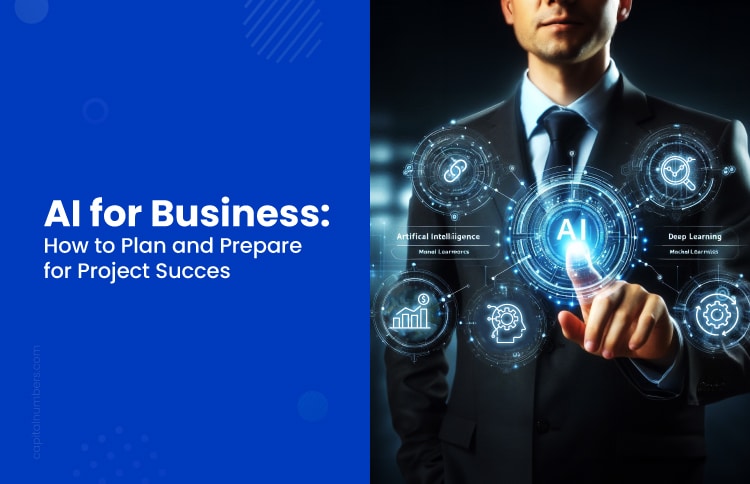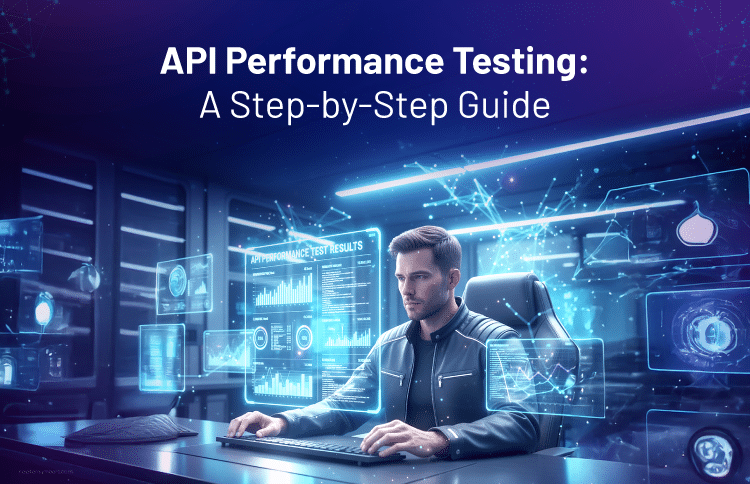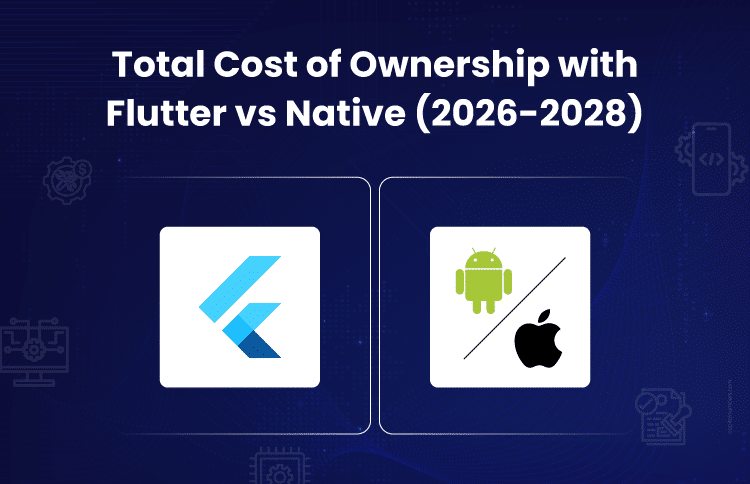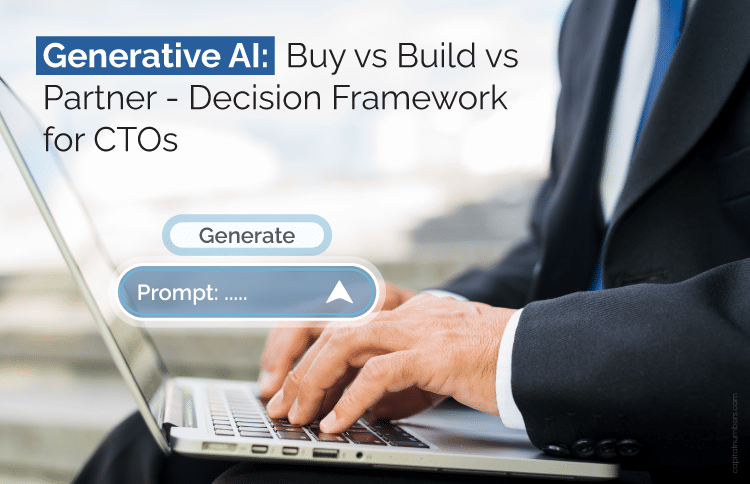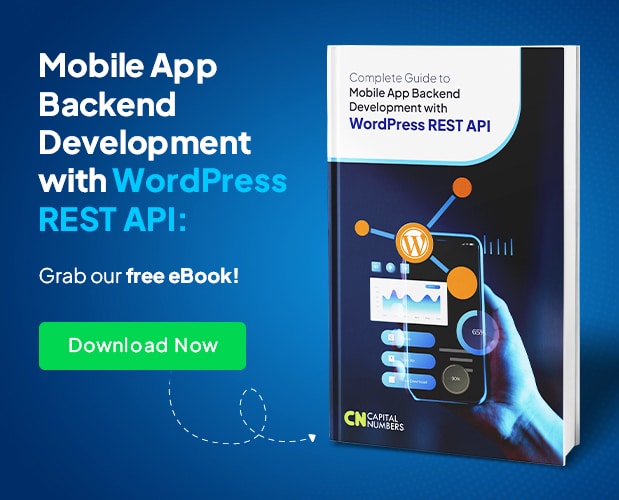AI for Business: How to Plan and Prepare for Project Success
Table of Contents
AI (Artificial Intelligence) is quickly becoming a must-have for businesses, and for good reason. It’s changing the way companies work by offering solutions that boost efficiency, simplify operations, and improve customer experiences. AI has the power to transform your business, helping automate routine tasks, make smarter, data-driven decisions, and deliver more personalized services.
But here’s the thing—like any big initiative, AI projects need proper planning. If you dive in without a clear plan, you might not get the results you’re hoping for. In this blog, we’ll walk through how to plan and prepare for AI projects so your business can get the most out of this powerful technology.
Understanding AI for Business
So, what exactly is AI? In simple terms, Artificial Intelligence (AI) is the ability of a machine to mimic human intelligence. Think of it as a super-smart system that can learn, reason, and problem-solve—just like we do. But instead of just following pre-set instructions, AI can actually improve over time by learning from data and adjusting its actions.
Now, let’s break it down a bit more. There are several types of AI that businesses can leverage, and each has its own superpower:
- Machine Learning: This is the foundation of AI. It allows systems to learn from data and improve their performance without being explicitly programmed for each task.
- Deep Learning: A subset of machine learning, deep learning uses artificial neural networks to process complex data patterns—think image recognition or speech processing.
- NLP: Natural Language Processing (NLP) helps machines understand and respond to human language. It’s the magic behind chatbots and virtual assistants.
- Computer Vision: AI that enables machines to see and interpret visual information, like identifying objects in images or videos.
How is AI being used in business?
AI isn’t just a futuristic idea—it’s already making waves in businesses across various industries. Here are some real-world applications:
- Customer Service Automation: Chatbots and virtual assistants are revolutionizing customer support by providing quick, automated responses to queries. No more waiting on hold!
- Predictive Analytics: AI can analyze past data to predict future outcomes, helping businesses make smarter decisions. Imagine knowing what your customers will want before they do.
- Personalization and Recommendation Systems: Whether it’s suggesting the perfect product or curating a tailored playlist, AI makes customer experiences more personalized.
- Process Automation: AI automates repetitive tasks, saving time and reducing errors. Think data entry, invoice processing, or even scheduling meetings.
- Supply Chain Management: AI helps optimize inventory levels, forecast demand, and streamline logistics, keeping operations running smoothly.
How AI is Driving Success Across Industries
AI is already changing the game in industries like retail, healthcare, and finance. For example:
- Retail: AI powers recommendation engines that suggest products based on browsing history and preferences, boosting sales and customer satisfaction.
- Healthcare: AI-driven diagnostic tools are helping doctors detect diseases faster and more accurately, improving patient outcomes.
- Finance: AI is revolutionizing finance by enabling real-time fraud detection, enhancing risk assessments, and providing personalized financial advice through AI-driven recommendation systems, leading to smarter, more secure financial decisions.
In short, AI isn’t just a buzzword. It’s a powerful tool that’s helping businesses work smarter, faster, and more efficiently. And as AI continues to evolve, the possibilities are endless!
You May Also Read: AI-Powered FinTech: The Future of Financial Software Development
Key Steps in Planning an AI Project
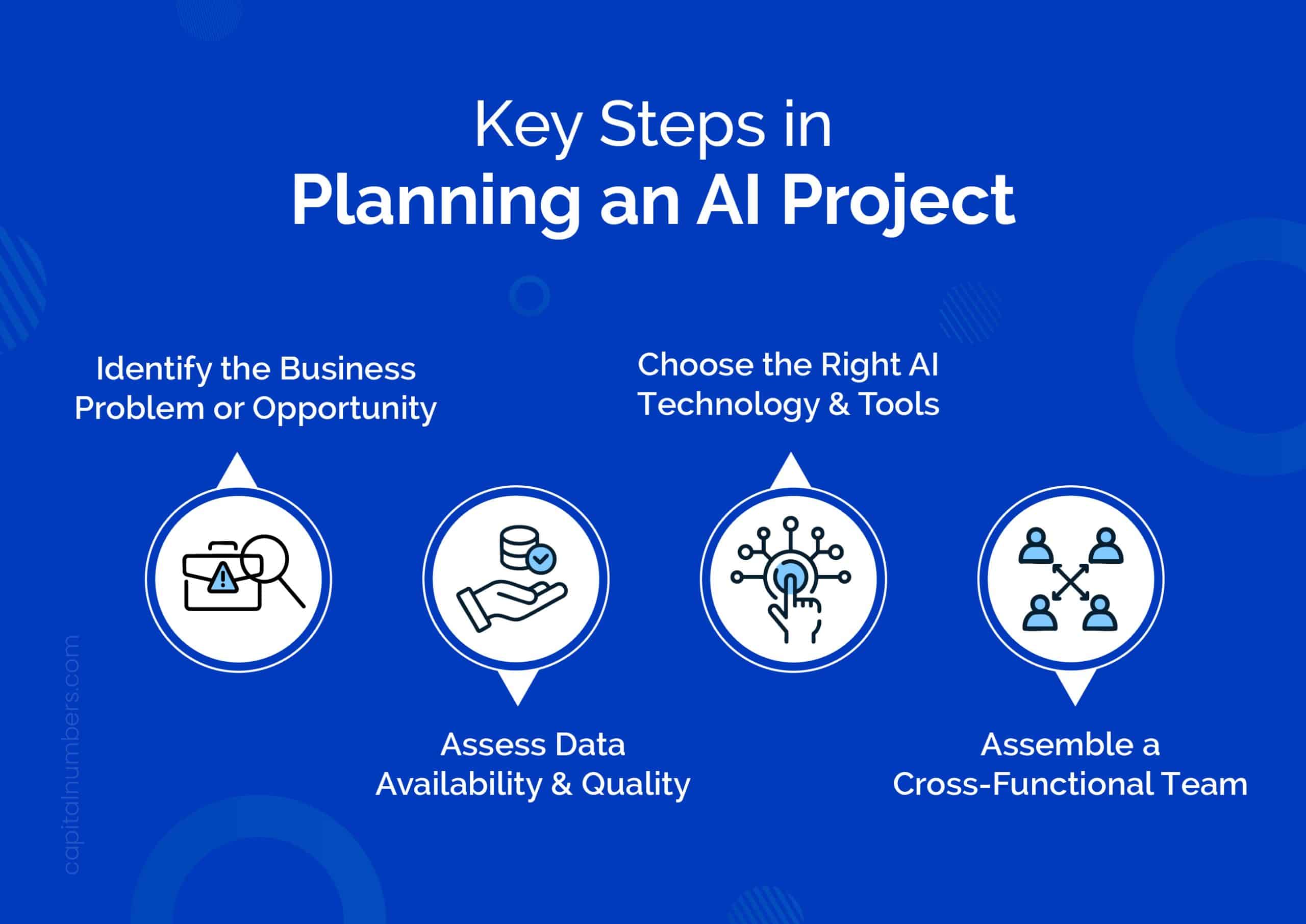
When it comes to AI, diving straight in without a plan can lead to confusion and missed opportunities. But don’t worry—we’ve got you covered. Let’s break down the key steps you need to follow to set your AI project up for success.
A. Identify the Business Problem or Opportunity
Before you even think about AI technology, take a step back. What’s the real problem you’re trying to solve? AI isn’t a one-size-fits-all solution—it needs to address a specific business issue or opportunity. Maybe you want to reduce customer churn, optimize your supply chain, or improve operational efficiency. Whatever it is, defining that goal clearly is crucial.
Once you’ve nailed down the problem, the next step is to figure out how AI fits into your overall business strategy. Ask yourself: How will AI help me meet my broader goals? Will it improve customer experience, cut costs, or drive innovation? Setting measurable objectives (like increasing productivity by 20% or reducing response times by 30%) will give you a roadmap for success.
B. Assemble a Cross-Functional Team
AI is not just for techies—it requires collaboration across the entire organization. You’ll need a diverse group of people, both technical and non-technical, working together. This means bringing in IT specialists, data scientists, business leaders, and domain experts.
Why? Because AI projects often touch on multiple areas of a business, so you need different perspectives. The data scientists will build the models, but the business leaders know the problem you’re trying to solve, and the domain experts provide the industry-specific knowledge. Everyone has a role to play.
Here’s what a strong AI team looks like:
- AI experts to design the models
- Data engineers to ensure data is collected and processed correctly
- Domain experts to align AI with industry needs
- Project managers to keep everything on track
- Business leaders to guide strategy and ensure alignment with company objectives
The key is ensuring that everyone understands their role and collaborates effectively.
C. Assess Data Availability and Quality
Now, here’s where things get serious: data. AI is only as good as the data it uses. If your data is messy, incomplete, or biased, your AI project won’t deliver the results you’re looking for. This is why auditing your existing data is essential.
Start by evaluating the type of data you have. Is it structured (think spreadsheets) or unstructured (like emails or images)? How complete is it? You may need to clean it up, fill in missing information, or even collect more data. And don’t forget about data governance and security—it’s crucial to ensure that your data is protected and complies with privacy regulations.
Once your data is in shape, you’re ready to move forward. Good data is the foundation of AI success.
D. Choose the Right AI Technology and Tools
Now for the fun part: choosing the right AI tools and technologies. There are many options out there, so how do you know which ones to pick? Start by evaluating the AI platforms, frameworks, and vendors that align with your project’s needs.
Ask yourself: Should we build the AI solution in-house, or would it be better to outsource it to a vendor with expertise in this area? Each approach has its pros and cons. Building in-house gives you more control, but outsourcing may save time and provide access to specialized skills.
You’ll also need to decide whether to go with open-source tools or proprietary software. Open-source options are usually more flexible and cost-effective, while proprietary tools often come with added support and features.
Lastly, consider whether a cloud-based AI solution or on-premise infrastructure is the best fit. Cloud-based AI is scalable and accessible from anywhere, making it a great choice for most businesses, while on-premise solutions offer more control and security, which may be important in industries with strict regulations.
With these steps, you’re well on your way to planning a successful AI project. Take your time, ask the right questions, and make decisions that align with your overall business strategy. AI success starts with smart planning!
Ready to drive business transformation with AI? Our AI/ML development services are here to guide you every step of the way.
Key Considerations to Ensure the Success of Your AI Project
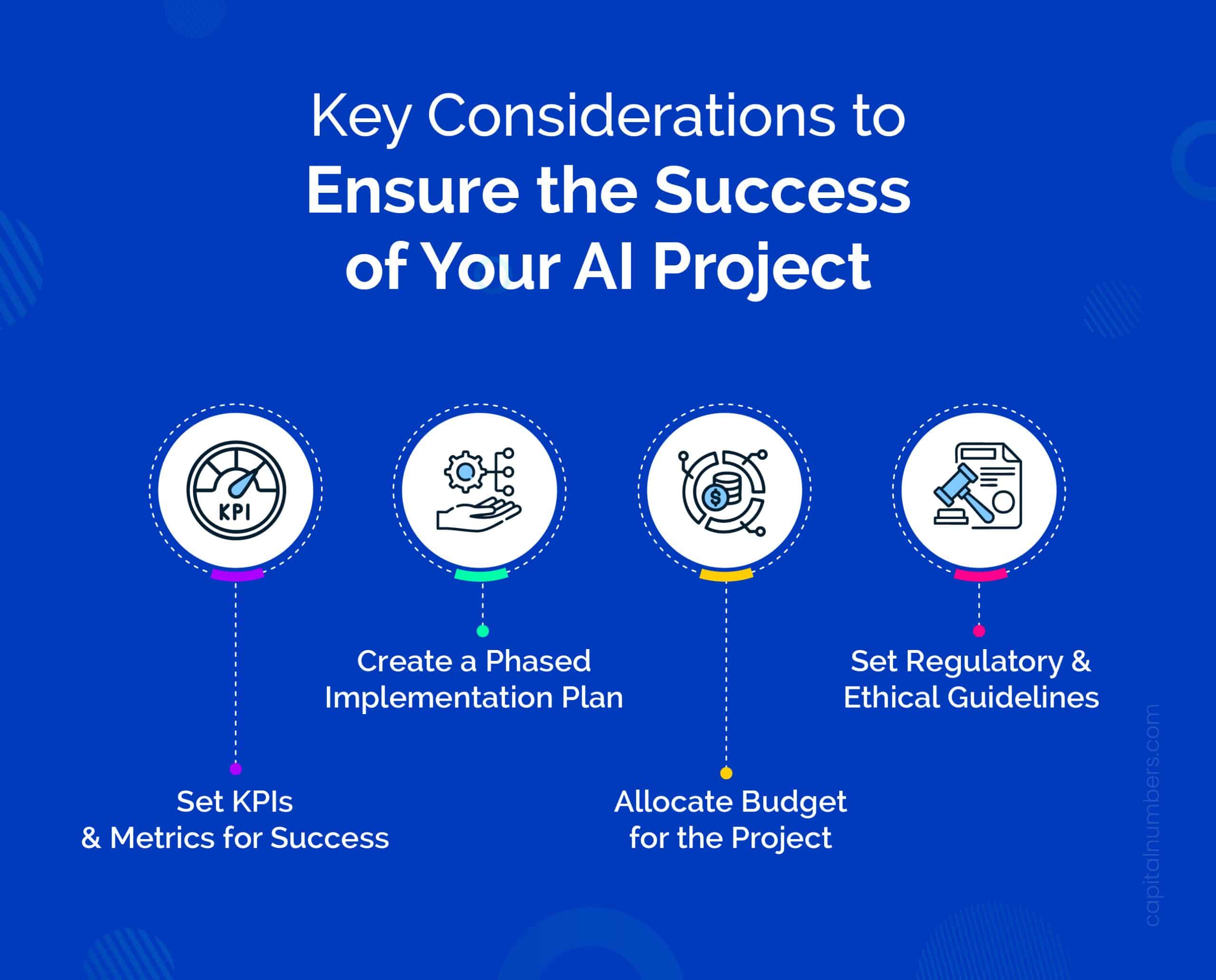
Planning an AI project is exciting, but ensuring its success requires careful consideration of a few key elements. Let’s dive into what you need to keep in mind as you move forward.
A. Set Clear KPIs and Metrics for Success
How do you know if your AI project is working? That’s where Key Performance Indicators (KPIs) come in. It’s all about setting clear metrics to measure the success of your AI initiative. These KPIs should align directly with your business goals. Are you aiming for a boost in ROI? Maybe you want to improve customer satisfaction or increase productivity? Defining these measurable outcomes early on helps keep your project on track and ensures you can demonstrate its value to stakeholders.
For example, if you’re using AI to improve customer service, track metrics like response time or customer feedback. If the goal is operational efficiency, measure things like cost savings or error reductions. Whatever your business needs, align your AI outcomes with these key goals to create a clear path to success.
B. Create a Phased Implementation Plan
Now, don’t rush to roll out AI across your entire business on day one—that’s a recipe for headaches. Instead, start small with pilot projects and proofs of concept. These mini-projects allow you to test the waters, identify potential issues, and fine-tune your approach before going all in.
Once your pilot shows promising results, it’s time to scale up. But scaling should be strategic and measured. Assess what worked in the pilot, adapt it to larger areas of the business, and move forward in phases. It’s like climbing a staircase—one step at a time, always building on previous success.
Also, be mindful of managing risks and setting realistic timelines. AI projects can be complex, so it’s essential to stay agile and be ready to adjust your plan as needed. Make sure you have a clear timeline that gives room for testing and iteration, not just immediate results.
C. Budgeting for AI Projects
Let’s talk about the dollars and cents. Budgeting for AI projects can be tricky because the costs depend on a variety of factors. You’ve got the obvious stuff like software and hardware, but don’t forget about personnel costs—you’ll need skilled data scientists, software developers, and AI specialists to make it all work. And what about data acquisition? AI thrives on data, so if you don’t already have it, you may need to invest in gathering or purchasing high-quality data.
Here’s the secret to budgeting for AI: align your budget with your business priorities. Not every AI project needs to be expensive, but you should focus your spending on the areas that will deliver the highest value. A phased approach can also help here—start small, and then allocate more resources as you scale.
D. Regulatory and Ethical Considerations
AI might be powerful, but with great power comes great responsibility (yes, we’re going there). AI ethics and bias are critical considerations in any AI project. You want to make sure your AI system is fair, transparent, and doesn’t unintentionally discriminate against any group of people.
It’s also essential to stay compliant with data privacy laws like GDPR and CCPA. AI often relies on large amounts of data, and that means you must ensure you’re handling personal data responsibly. Understanding these regulations and incorporating data privacy safeguards into your project is key.
And don’t forget about AI transparency and accountability . Your stakeholders and customers should know how your AI is making decisions, especially if it’s impacting their lives. Keeping things clear and ethical will build trust in your AI solutions and protect your business from legal and reputational risks.
You May Also Read: AI Ethics: Balancing Innovation and Responsibility in AI Development
Common Challenges in AI Projects and How to Overcome Them
Let’s be real—AI projects are exciting, but they come with their own set of challenges. Whether it’s poor data quality, organizational pushback, or technical hurdles, every AI journey has bumps along the way. But don’t worry, we’ve got some handy solutions for you.
A. Lack of Data or Poor Data Quality
AI feeds on data. Without good data, your AI project won’t have the fuel it needs to succeed. But often, businesses face a lack of data or find that the data they do have is messy, incomplete, or unreliable. Don’t panic! There are ways to turn this around, and data engineering services can play a crucial role in ensuring your data is properly structured and ready for AI implementation.
Step 1: Data Cleaning. Think of it as tidying up your data. This involves removing duplicates, correcting errors, and filling in missing values. You want your data to be as accurate and consistent as possible before feeding it into your AI model.
Step 2: Data Augmentation. If you’re short on data, you can boost your dataset by using synthetic data (artificially generated data) or supplementing it with publicly available datasets. These strategies help ensure you have enough high-quality data for your AI project to thrive.
And what if some data is just missing? No worries—techniques like data imputation can help fill in those gaps by making educated guesses based on existing data patterns.
B. Resistance to Change within the Organization
Implementing AI isn’t just a technical challenge—it’s a cultural one. People in your organization might be resistant to change, especially when it comes to adopting new technologies like AI. It’s natural for some employees to feel uncertain or even threatened by automation.
The key here is communication and training. Be transparent about the benefits AI can bring, both for the company and for individuals. Will it make their jobs easier? Help them focus on more meaningful tasks? Highlight the positives.
Another great way to foster a culture of innovation is by offering training sessions. Help employees understand how AI works and how they can leverage it in their day-to-day roles. When people feel included and empowered, they’re more likely to embrace change rather than resist it.
C. Unrealistic Expectations
Let’s face it, AI is cool, but it’s not magic. Sometimes, businesses expect AI to solve every problem overnight. And when that doesn’t happen, disappointment sets in. Managing these expectations is crucial.
Start by setting achievable short-term and long-term goals. For example, don’t expect an AI system to transform your entire business in one go. Instead, focus on small wins, like automating a specific task or improving a particular process. Once you’ve had success with smaller projects, you can scale up.
It’s also important to educate your stakeholders about the limitations of AI. Sure, AI can handle complex tasks, but it still requires data, time, and adjustments. The more realistic your expectations, the better positioned your AI project will be for long-term success.
D. Technical Challenges
Integrating AI into your existing systems can sometimes feel like trying to fit a square peg into a round hole. Many businesses rely on legacy systems that weren’t built with AI in mind, making integration a challenge.
One solution is to gradually upgrade or modify your existing infrastructure. You don’t have to overhaul everything at once, but rather, focus on making incremental changes that support AI. Partnering with a skilled AI development company can also help ensure that integration goes smoothly.
Then there’s the issue of algorithmic bias and model accuracy. AI models can sometimes reflect biases present in the data they’re trained on. The key here is to regularly audit your AI models for biases and make adjustments as needed. Likewise, fine-tuning your models will help improve their accuracy over time.
The Role of Continuous Improvement in AI Projects
So, you’ve launched your AI project—congratulations! But don’t sit back just yet. AI isn’t a “set it and forget it” kind of deal. To truly unlock its potential, you need to keep improving, tweaking, and learning. Let’s dig into how you can ensure ongoing success with continuous improvement.
A. Importance of Monitoring and Optimization
AI is like a plant—it needs regular attention to thrive. Just because you’ve built a model doesn’t mean the work is done. Monitoring AI performance over time is crucial. You’ll want to track metrics like accuracy, response times, and effectiveness against your business goals. Is the AI doing what you intended? If it starts to drift, you’ll need to step in.
Feedback loops are your secret weapon here. By gathering data on how your AI performs and feeding that back into the system, you can continuously improve the model. Think of it as a cycle of refinement—your AI keeps learning and getting better. And remember, as your business grows and evolves, so should your AI. Updating and maintaining your models is key to keeping them relevant as new data comes in and business needs shift.
B. Learning from Pilot Projects
Pilot projects are like AI test runs, and they offer you a goldmine of learning opportunities. Whether your pilot was a roaring success or faced some bumps along the way, there’s always something valuable to take away.
If your pilot was a hit, great! Now you can analyze exactly what made it work. Was it the data? The algorithms? The specific problem you were solving? Use these insights to shape your broader AI strategy.
On the other hand, if the pilot didn’t go as planned, don’t panic. Pilots are meant to be low-risk, learning experiences. Figure out where things went wrong—was it the data quality, the AI model itself, or perhaps the integration with existing systems? By evaluating pilot outcomes carefully, you can refine your approach, adjust expectations, and set up future AI projects for success.
C. Building an AI-Driven Culture for the Future
AI isn’t just about the technology; it’s about creating a long-term strategy that involves people, processes, and technology working together. As your business scales its AI capabilities, you need to foster an AI-driven culture across the organization.
First, develop a clear roadmap for scaling AI beyond initial projects. How will AI be used in different departments? What processes can be automated or enhanced with AI? Setting a long-term AI strategy ensures that you’re not just dabbling in AI but embedding it deeply into your business operations.
And then, there’s the human side. Technology is evolving fast, so how do you ensure your teams stay ahead? The answer lies in training and upskilling. Equip your teams with the knowledge they need to understand and work alongside AI. Regular workshops, learning sessions, and hands-on experiences can help keep everyone AI-savvy. After all, a tech-savvy team is the backbone of an AI-driven future.
In short, continuous improvement in AI isn’t just about fine-tuning your models—it’s about building a sustainable strategy, learning from every project, and creating a culture that embraces innovation. Keep optimizing, keep learning, and your AI initiatives will thrive!
Conclusion: Set Your Business Up for AI Success
The key to AI success lies in careful planning and preparation. Starting small with pilot projects allows you to test the waters, learn, and gradually expand your AI capabilities. This phased approach ensures that your AI efforts align with your business goals and deliver real value. With the right strategy in place, AI can transform your operations, boost efficiency, and unlock new opportunities. As AI continues to evolve, businesses that plan strategically today will be better positioned to thrive in the AI-driven future. Embrace the journey, and watch your business grow with AI!
Want to stay ahead of the competition with AI? Contact us today to learn how our expert team can develop custom AI solutions tailored to your needs.

